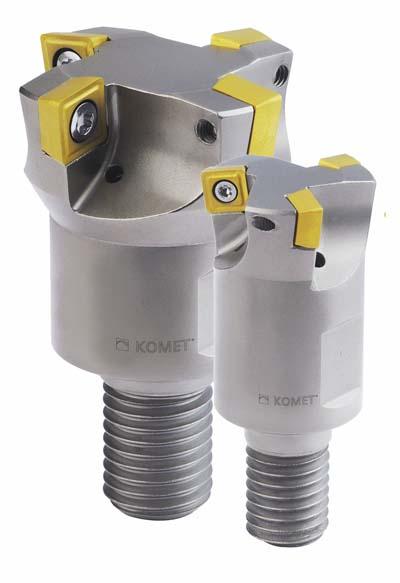
With the KOMET of America Inc. Quatron hi.feed milling cutters, KOMET says it is replicating the success of its KUB Quatron drills in a new range of milling cutters. For roughing operations, this tool variant enables machinists to use the four-effective indexable inserts for both drilling and plunge milling. The most striking feature of these universal tools is the four-effective Quatron indexable insert, according to the company. For years it has been the preferred solution for drilling operations, remarkable not only for the number of its cutting edges, but above all for its rapid removal of high chip volumes.
These properties are now replicated in the new KOMET Quatron hi.feedmilling cutters. In addition, the Quatron indexable inserts also have a radial cutting action, which affords a considerably higher degree of flexibility in plunge and pocket milling by comparison with two- or three-edged inserts. Machinists who need to cut deep grooves or large cavities in their workpieces often opt for plunge milling due to the dimensions or cutting capacities of the tools or the performance of the spindle inside the machine. Rather than boring with the use of multiple boring tools, it is possible to achieve various diameters and complex contours in one roughing operation by milling with an axial and a horizontal feed.
Another bonus is that the KOMET Quatron hi.feed can use the very same indexable inserts for drilling as well as milling. The BK8425 coating delivers exceptional tool life while enabling universal use of these milling cutters for steel, cast iron and stainless materials.
Contact Details
Related Glossary Terms
- boring
boring
Enlarging a hole that already has been drilled or cored. Generally, it is an operation of truing the previously drilled hole with a single-point, lathe-type tool. Boring is essentially internal turning, in that usually a single-point cutting tool forms the internal shape. Some tools are available with two cutting edges to balance cutting forces.
- feed
feed
Rate of change of position of the tool as a whole, relative to the workpiece while cutting.
- gang cutting ( milling)
gang cutting ( milling)
Machining with several cutters mounted on a single arbor, generally for simultaneous cutting.
- indexable insert
indexable insert
Replaceable tool that clamps into a tool body, drill, mill or other cutter body designed to accommodate inserts. Most inserts are made of cemented carbide. Often they are coated with a hard material. Other insert materials are ceramic, cermet, polycrystalline cubic boron nitride and polycrystalline diamond. The insert is used until dull, then indexed, or turned, to expose a fresh cutting edge. When the entire insert is dull, it is usually discarded. Some inserts can be resharpened.
- milling
milling
Machining operation in which metal or other material is removed by applying power to a rotating cutter. In vertical milling, the cutting tool is mounted vertically on the spindle. In horizontal milling, the cutting tool is mounted horizontally, either directly on the spindle or on an arbor. Horizontal milling is further broken down into conventional milling, where the cutter rotates opposite the direction of feed, or “up” into the workpiece; and climb milling, where the cutter rotates in the direction of feed, or “down” into the workpiece. Milling operations include plane or surface milling, endmilling, facemilling, angle milling, form milling and profiling.
- plunge milling
plunge milling
Highly productive method of metal removal in which an axial machining operation is performed in a single tool sequence. The tool makes a series of overlapping, drill-like plunges to remove part of a cylindrical plug of material one after another. Because of the increased rigidity of a Z-axis move, the tool can cover a large cross-section of material.
